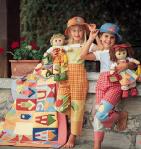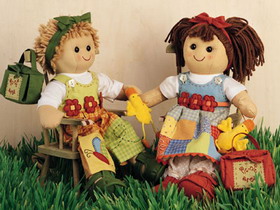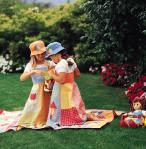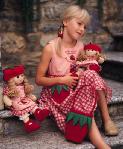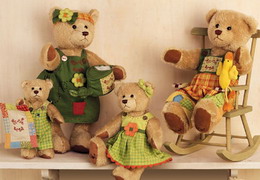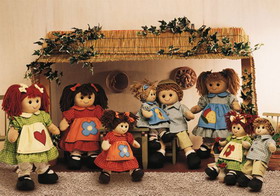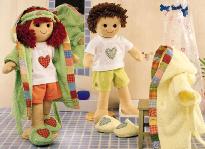Items Produced by Slave Labor in Chinese Labor Camps Appear on Renowned Italian Brand-Name Website (Photos)
(Clearwisdom.net) (Note: LiYing, the author of this article, was imprisoned in the Shanghai Women's Forced Labor Camp from December 2001 to October 2003 because she practices Falun Gong. In late November 2003, she was released from the labor camp and went to Australia. This was made possible with help from Falun Gong practitioners in Australia, the Australian government and other kind-hearted Australian people.)
When anyone looks at these pictures, it is unlikely that they would associate the young girls pictured, dolls in their hands, with Chinese forced labor camps. All of these pictures were downloaded from www.mydoll.it/ . Dolls exactly like this were made in Division Three of the Shanghai Women's Forced Labor Camp between June 2002 and May 2003. Some were packaged and shipped directly to Italy, and others were sent to other locations for further processing or assembly.
The dolls, in three sizes, arrived at the labor camp in large sacks. The largest size, as seen in the first picture, came 100 dolls per sack. The smallest size came 500 dolls per sack. The dolls were laid out on the ground after they arrived. Some were moldy from the summer heat. Prisoners put clothes on them, so the buyers could not see how filthy the dolls really were underneath.
There were time deadlines for the products that were about to be exported. Labor camp detainees, including illegally held Falun Gong practitioners, were forced to work from at least 7:00 a.m. to 9:00 p.m. Most people worked until around 11:00 p.m. since the daily work quota was impossible for them to finish in 10 hours.
Dolls like the one in the hands of the girl on the right were packaged in Group One of Division Three. The detainees were forced to work until past midnight in order to finish by the deadline.
The process of packaging was as follows: we put a T-shirt and pants on the doll, put a belt on a coat, put the coat on the doll, put a headband on the doll and put shoes on the doll's feet. We cut off thread ends from inside to outside, combed the hair, put the fully clothed doll in a white cloth sack, put a drying agent under the doll's buttocks, then wrapped it in a transparent plastic bag, folded the paper box and put the fully packaged doll in the paper box. Each person was assigned 120 dolls a day.
The doll on the left wears overalls. The flower pattern on the bottom end of the right pant leg is completely handmade. First, we put the agglutinated lining on the back of three pieces of cloth altogether, and used an electric iron to iron the cloth onto a yellow base cloth, and then used a pencil to draw the two antenna of the snail, and used three different color threads, sewing the three pieces of cloth to the yellow base cloth according to the requirements. The stitch was no longer than 0.5 centimeter, and the distance between two stitches was around 0.5 centimeters; the stitches had to be symmetrical and the stitch-lengths had to be the same. The antenna was embroidered with a coffee-colored piece of thread clipped to a pin. The bottom end of the left pant leg also followed the same requirements. It had to be in the shape of a curve and could not look rigid. We also embroidered a line around the collar of the overalls with 0.5 centimeters between stitches. The doll on the right had its collar embroidered on the same way.
Who would imagine that not only are the dolls in the hands of these cute young girls products of slave labor, but so are the hats and pants the girls are wearing.
In Picture 1, the flower on the right pant-leg of the girl on the left was embroidered by hand, stitch by stitch. The requirement was that the thread had to be invisible; the edges could not be rough; the flower could not be oblique and had to be smooth. The labor camp was only responsible for embroidering the flower; the pants themselves were manufactured elsewhere.
The hats worn by both girls and the flowers on them were also made at the labor camp. A circular line was embroidered onto the hat, and the line could not get inside of the hat lining.
The little house with a chimney pictured on the carpeting was also partially made in the labor camp and consisted of seven pieces of cloth. Every piece of cloth was embroidered to the bottom cloth according to their sequence.
The flower and little house on the dresses worn by the girls were also embroidered at the labor camp.
The packaging process of the dolls the girls are holding was as follows: first we put the pants on the doll, making sure the tag was in back. We put a dress, an apron and shoes on the doll. We cut off the thread and combed the ponytails. We put the hat on the doll and put it in a white cloth sack, put a drying agent under the doll's buttocks, then wrapped it in a transparent plastic bag, folded the paper box and put the fully packaged doll in the paper box. Each person was assigned to package 120 dolls a day.
The strawberry bag in front of the girl's feet was made at the labor camp. Both sides of the bag were embroidered with lines. After completion, it was diamond-shaped with a three-dimensional feel to it. The lines could not curve and the stitches had to be even and smooth.
The pants and the flower pattern on the right pant-leg of the toy bear sitting on the chair were also partially made in the labor camp.
Picture 6
The sunflower on the dress of the doll on the rear left was embroidered on. A line was sewn onto the bottom of the apron and the collar. It was required that the stitches be even and that no more than a 0.5-centimeter gap existed between stitches. The connecting stitches and threads should be invisible. The head flower was also made in the labor camp.
The packaging process was as follows: we put the pants on the doll. We positioned the pants so the doll's legs were not exposed; we put shoes with white socks on the doll's feet, we folded the socks twice down and put the dress on the doll, affixed the head flower on the doll and wrapped it around its head two times. We cut the threads and combed the hair. We put the hat on the doll and put it in a white cloth sack, put drying agent under the doll's buttocks, then wrapped it in a transparent plastic bag, folded the paper box and put the fully packaged doll in the paper box. Each person was assigned to package 120 dolls a day.
The rubber band used to fix the head flower onto the doll's head was very tight and we had to wrap it around twice. After one day's work, our thumbs and index fingers were red and swollen. Nevertheless, we had to continue our work the next day, until the skin on our fingers broke open and bled.
The flower patterns on the doll dresses in this picture were all embroidered at the labor camp. One line was embroidered smoothly on the collar and the bottom of the apron, with a space of 0.5 centimeters between stitches. The packaging process and amount of work is the same as in picture 6.
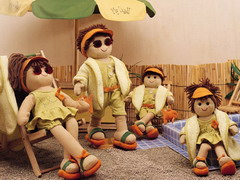 Picture 8 |
| 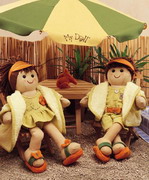 Picture 9 |
The butterflies and their wake [the trail by which the butterfly flew] on the dolls' clothes were done at the labor camp. It was required that the line along which the butterflies were stapled be invisible and the butterflies' traces must be even and smooth, with no rigid corner or lines.
The packaging process for this doll was the same as the doll in picture one.
The photos published on this website only show some of the products we were forced to make at the labor camp. We were also assigned to work on the single-packed clothing, backpacks, and other accessories that went along with the dolls.
